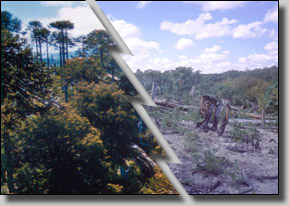Human Influences
Mostly, from what we have studied about mass movements so far, you probably are only thinking in terms of naturally occurring mass movements. However, there are anthropogenic (human) activities that have a large effect on long-term mass movements as well. The two of main concern for us are deforestation and building.
Deforestation is the removal of plants and trees from a large area so that it can be used for human activity. The human activity can be defined as anything that is not the natural use for the area. One of the kind-of non-obvious forms of deforestation is the conversion of natural land to farm/grazing land. While this is the first time deforestation is a topic in this course, it will not be the last. It has detrimental effects in all 4 spheres and is one of the human activities that has the worst consequences.
To understand how deforestation effects mass movements, we first must understand the importance of vegetation to soil. If a forest is undisturbed, very little soil moves or is lost from the area. The leaf litter (fallings that sit on the ground) protect the soil from erosion. If the trees and vegetation are removed and replaced with something else, the leaf litter can not accumulate, and thus the soil is susceptible to water running it off or wind erosion. Soil without vegetation will not absorb water well either, so the rate of runn-of will increase. The root structure of trees also stabilize the soil underneath the ground cover, so their removal leaves the soil loose and more likely to erode. If the soil is loose, not only is is susceptible to erosion, if it is on a slope, it can cause landslides.
Check out this picture from Chile showing an area before and after deforestation. You can see how the loss of vegetation can leave the area wide open to destruction.
Building structures on land and the clearing of that land can have the same effects as deforestation. Another major problem is that land is moved to different places, and usually that soil is loose where it moves, and thus susceptible to erosion. Buildings also take away natural drainage systems and then cause the water to move over places it normally wouldn't, which could cause erosion in those parts or flooding.
Causes of Sudden Mass Movements
Sudden, unexpected mass movement of land (ex. landslides) can be the result of natural phenomena or due to human interference. The following will give you a short overview of some events in both categories.
Natural
Natural
- Massive intense and/or prolonged rainfall - can loosen up the soil, and create heavier flowing soil
- Earthquake - simple enough...earth shakes, soil becomes loos, flows down a slope. Also can cause liquefaction, where the pores in soil are compacted by the seismic vibrations from an earthquake, causing deformation of the land, possible breakage and flow.
- Volcanic activity - pretty much the same as with earthquakes...the seismic activity can trigger movement of land. Also, the vents and features associated with a volcano will be weak following the eruption, may collapse, and take land with them.
- Snowmelt - If there is a sudden increase in temperature in a mountainous region with heavy snow, the snow will melt, causing a mass movement of water, which may result in landslides.
- Rapid falling levels of groundwater or surface water - The water level adjacent or below an area of land may be susceptible to rapid decline after a flood or during a particularly high-temperature event. The water level acts as a barrier to a slope, and without it, the soil may give way to a landslide.
- Excavation - as humans excavate land, they inherently destroy the structure that it established for that area. This can leave an area more in danger of the natural events described above causing landslides than if the area was left alone.
- Mining - Digging into the earth to get some of the valuable materials can leave the earth scarred...and filled with more empty space. Empty space may collapse, and thus, trigger mass movement.
- Vibration - Many human processes cause vibration of the land (think of a jackhammer). Think of this as a "human earthquake" - can destabilize the land in the same way and cause liquefaction.
- Drawdown - When water is drawn down from a water body, the same effect as the groundwater or surface water natural cause may occur.
- Explosions - We use explosions for many things...from mining to fracking (getting natural gas from the ground), explosions have their use...and are pretty awesome! However, if the land is not stable enough, explosions can trigger mass movements by being the "spark" that causes the movement.
- Deforestation/Land Use Change - As shown above, deforestation or changing the use of a land can cause slow mass movement. It can also leave the are much more prone to sudden mass movement, as the soils are loose and not covered.

Great Article, Thanks For Sharing Information. Environmental Management Services is a fully bonded and insured woman-owned minority business. We are an industry leader and offer a complete spectrum of environmental services for all who are required to properly characterize and manage hazardous materials and waste.
ReplyDeleteThank you maranara
DeleteYou're a real one maranara
Delete